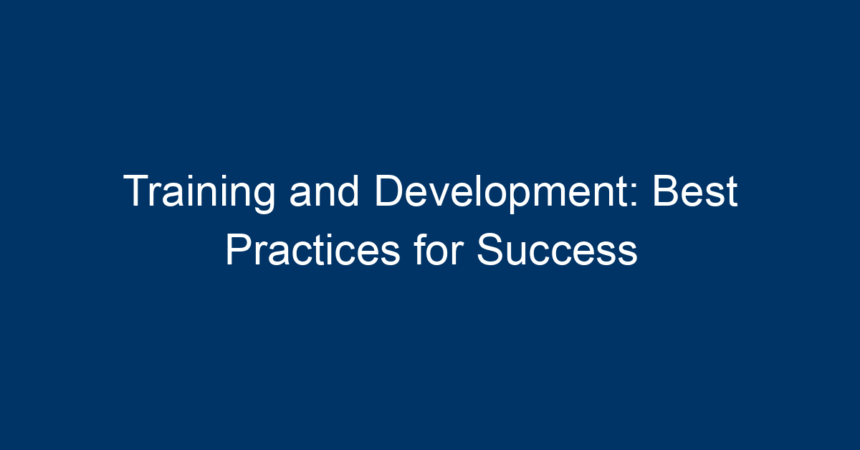In today’s fast-paced corporate world, organizations must prioritize training and development to thrive. A skilled workforce not only drives innovation but also enhances overall productivity, leading to sustainable business growth. This article delves into the best practices for successful training and development strategies, providing actionable insights to help organizations elevate their workforce’s capabilities.
The Importance of Training and Development
Training and development are critical components of a successful organization. They encompass various educational activities aimed at improving employee skills, knowledge, and performance. Investing in these areas leads to:
- Increased Employee Engagement: Employees who receive training feel valued and are more engaged in their work.
- Higher Retention Rates: Organizations that prioritize development often enjoy lower employee turnover.
- Enhanced Productivity: Well-trained employees can perform their tasks more efficiently and effectively.
- Adaptability to Change: Continuous learning prepares employees to adapt to industry changes and technological advancements.
Incorporating a robust training and development strategy not only benefits the workforce but also the organization as a whole.
Identifying Training Needs
Assessing Skills Gaps
The first step in building a successful training and development program is to assess the existing skill levels of employees. This can be done through:
- Surveys: Utilize employee surveys to gather feedback on areas where employees feel they require additional training.
- Performance Evaluations: Regular performance reviews can highlight skill gaps and areas needing improvement.
Setting Clear Objectives
Once the skills gaps are identified, it’s essential to set clear and measurable objectives for the training programs. Defining specific goals—whether it’s improving customer service skills or mastering new software—ensures that the training is targeted and effective.
Designing Effective Training Programs
Choose the Right Format
Different employees have various learning styles, so it’s crucial to select the right training format. Here are some popular methods:
- In-Person Workshops: Ideal for hands-on training and team-building exercises.
- E-Learning Modules: Flexible and accessible, employees can learn at their own pace.
- On-the-Job Training: Practical experience is invaluable and allows employees to apply what they’ve learned immediately.
Incorporate Diverse Learning Materials
Diversity in training materials keeps employees engaged. Consider a mix of:
- Videos: Short clips can effectively illustrate complex concepts.
- Interactive Quizzes: These reinforce learning and provide instant feedback.
- Case Studies: Real-world examples help employees apply theoretical knowledge.
Foster a Blended Learning Environment
Combining various training methods creates an engaging learning environment that accommodates different preferences. For example, a blended learning approach may involve e-learning modules supplemented by in-person workshops for practical application.
Implementing the Training Program
Communicate Effectively
Effective communication is vital for the successful rollout of training initiatives. Clearly outline what the training entails, its importance, and how it will benefit employees. Regularly update employees on progress and encourage feedback to ensure transparency.
Involve Leadership
Leadership buy-in is crucial for promoting a culture of continuous learning. Leaders should actively participate in training sessions and advocate for employee development. This not only reinforces the importance of training but also encourages participation from the entire team.
Monitoring and Evaluating Training Success
Key Performance Indicators (KPIs)
Measuring the success of training and development programs is essential for continuous improvement. Establish KPIs such as:
- Employee Feedback: Conduct post-training surveys to gather insights on the training effectiveness.
- Knowledge Retention: Test employees on what they’ve learned after training.
- Performance Metrics: Assess if there’s an increase in productivity or efficiency in relevant tasks.
Ongoing Assessment and Revision
Training and development should be an iterative process. Use feedback and performance metrics to continuously improve training programs. Regularly assess whether the training meets the evolving needs of the organization and make necessary adjustments.
Creating a Culture of Continuous Learning
Encourage Knowledge Sharing
Fostering an environment where employees can share knowledge and skills promotes ongoing learning. Consider implementing:
- Mentorship Programs: Pairing experienced employees with newer ones can facilitate knowledge transfer.
- Lunch-and-Learn Sessions: Casual gatherings where employees share insights or skills in an informal setting can enhance team bonding and learning.
Promote Professional Development
Encouraging employees to pursue further education or certifications demonstrates an organizational commitment to their growth. Providing financial assistance or time off for education can motivate employees to enhance their skills continually.
Harnessing Technology for Training and Development
Learning Management Systems (LMS)
Investing in a robust Learning Management System can streamline the management and delivery of training programs. An LMS allows organizations to:
- Track employee progress and completion rates.
- Store and access training materials easily.
- Customize training programs to fit the specific needs of the workforce.
Virtual Reality and Augmented Reality (VR/AR)
Emerging technologies like VR and AR offer immersive learning experiences that can bridge the gap between theory and practice. Industries such as healthcare and manufacturing can benefit tremendously from these advanced tools.
Conclusion: Actionable Insights for Successful Training and Development
To harness the full potential of training and development, organizations must adopt a holistic approach. By assessing skill gaps, setting clear objectives, employing diverse training methods, promoting knowledge sharing, and leveraging technology, companies can build a skilled and adaptable workforce.
Key Takeaways:
- Prioritize Assessment: Regularly assess skill gaps and set targeted training objectives.
- Diverse Learning Formats: Implement a mix of training methods to cater to different learning styles.
- Monitor and Evaluate: Use KPIs to gauge training effectiveness and encourage ongoing revisions.
- Cultivate a Learning Culture: Encourage knowledge sharing and promote continuous professional development.
With these best practices, organizations can create a robust training and development program that not only uplifts employee performance but also drives overall business success. Embrace the journey of continuous learning, and watch your organization thrive!




